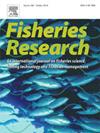Modeling spatio-temporal dynamics of Patagonian toothfish spawning in Kerguelen waters using CPUE data
IF 2.3
2区 农林科学
Q2 FISHERIES
引用次数: 0
Abstract
The act of spawning of fish can be influenced by a variety of factors, including environmental conditions and human activities, particularly fishing. Patagonian toothfish (Dissostichus eleginoides) is a commercially exploited fish species, occupying the southern Patagonian and Chilean shelves, as well as the sub-Antarctic submarine plateaux. It is characterized by a late maturity and slow body growth, which are key considerations in its management and conservation. In this study, we investigated the spatio-temporal dynamics of Patagonian toothfish spawners in the Kerguelen region using fishery observer data, from 2020 to 2024. We predicted spawner hotspots and seasonal trends of spawner abundance using spatially-explicit Generalized Additive Models (GAMs) that modeled the spawner CPUE (Catch Per Unit of Effort). Our results suggest that toothfish female spawners aggregate at specific locations from early June to the end of July. Hotspots of male spawners were found from mid-June to mid-July and then from mid-August to mid-September. The main spatial overlap between male and female spawner hotspots is located on the western slopes and the north of Skiff bank (along the 1500 m isobath) and in the north-western region (near the 500 m isobath). Our findings enabled the formulation of hypotheses concerning the ecological drivers influencing Patagonian toothfish spawning and emphasize the importance of considering seasonal localized closures to avoid mortality and disturbance during spawning.
利用CPUE数据模拟Kerguelen水域巴塔哥尼亚齿鱼产卵的时空动态
鱼类的产卵行为可受到多种因素的影响,包括环境条件和人类活动,特别是捕鱼。巴塔哥尼亚齿鱼(Dissostichus eleginoides)是一种商业开发的鱼类,占据了南巴塔哥尼亚和智利的大陆架,以及亚南极海底高原。它的特点是成熟晚,体生长慢,这是管理和保护的关键因素。利用渔业观测数据,研究了2020 - 2024年克尔格伦地区巴塔哥尼亚齿鱼产卵的时空动态。利用空间显式广义加性模型(GAMs)预测了产卵热点和产卵丰度的季节性趋势,该模型模拟了产卵者CPUE(每单位努力渔获量)。我们的研究结果表明,从6月初到7月底,雌牙鱼产卵在特定地点聚集。6月中旬至7月中旬和8月中旬至9月中旬分别是雄鱼产卵的热点。雄性和雌性产卵热点的主要空间重叠位于西坡和Skiff bank北部(沿1500 m等深线)以及西北地区(靠近500 m等深线)。我们的研究结果使关于影响巴塔哥尼亚齿鱼产卵的生态驱动因素的假设得以形成,并强调了考虑季节性局部封闭以避免产卵期间死亡和干扰的重要性。
本文章由计算机程序翻译,如有差异,请以英文原文为准。
求助全文
约1分钟内获得全文
求助全文
来源期刊

Fisheries Research
农林科学-渔业
CiteScore
4.50
自引率
16.70%
发文量
294
审稿时长
15 weeks
期刊介绍:
This journal provides an international forum for the publication of papers in the areas of fisheries science, fishing technology, fisheries management and relevant socio-economics. The scope covers fisheries in salt, brackish and freshwater systems, and all aspects of associated ecology, environmental aspects of fisheries, and economics. Both theoretical and practical papers are acceptable, including laboratory and field experimental studies relevant to fisheries. Papers on the conservation of exploitable living resources are welcome. Review and Viewpoint articles are also published. As the specified areas inevitably impinge on and interrelate with each other, the approach of the journal is multidisciplinary, and authors are encouraged to emphasise the relevance of their own work to that of other disciplines. The journal is intended for fisheries scientists, biological oceanographers, gear technologists, economists, managers, administrators, policy makers and legislators.
 求助内容:
求助内容: 应助结果提醒方式:
应助结果提醒方式:


